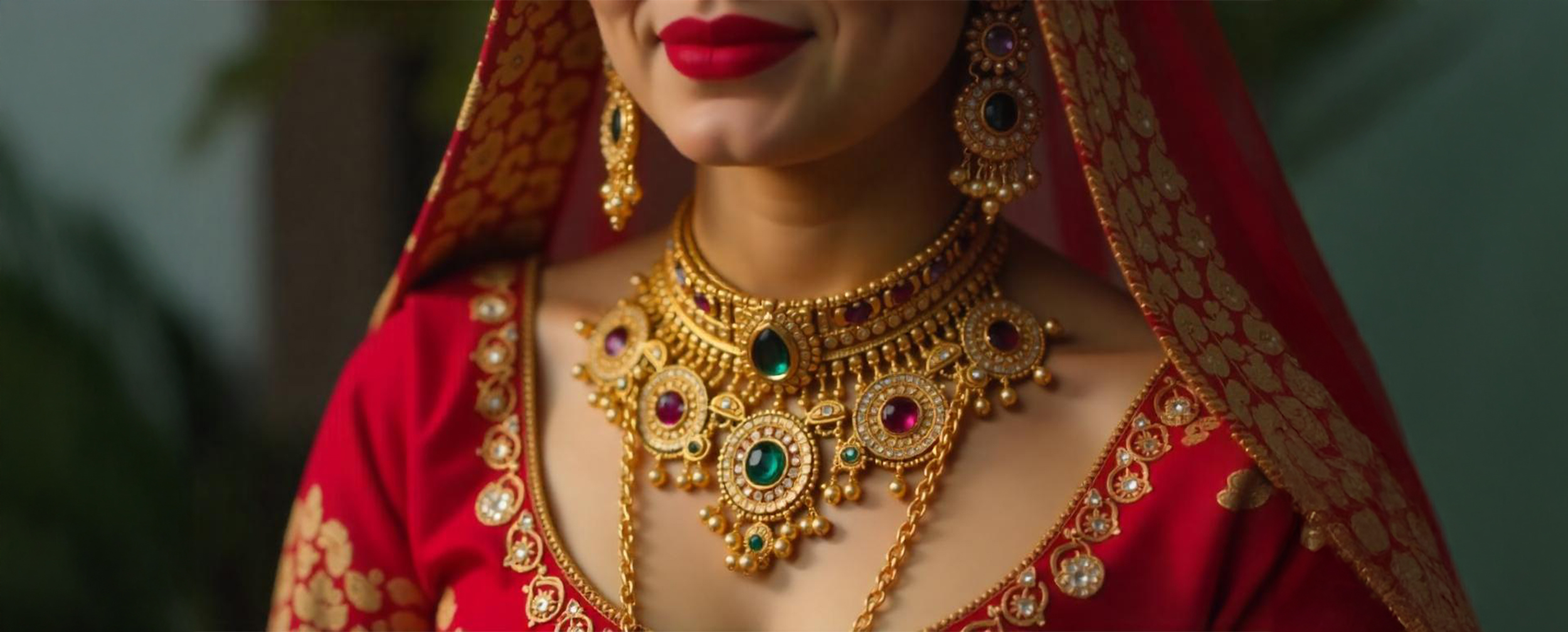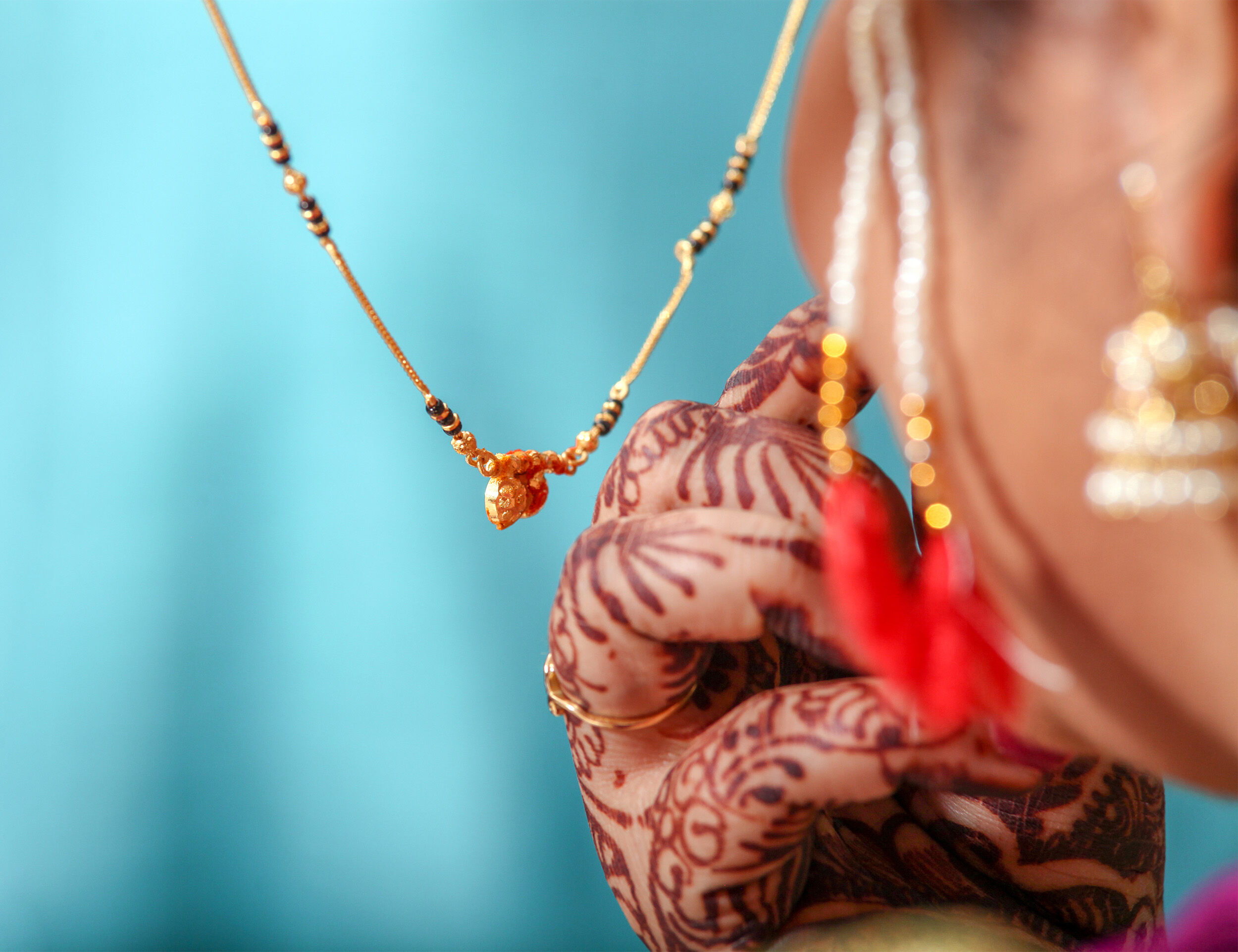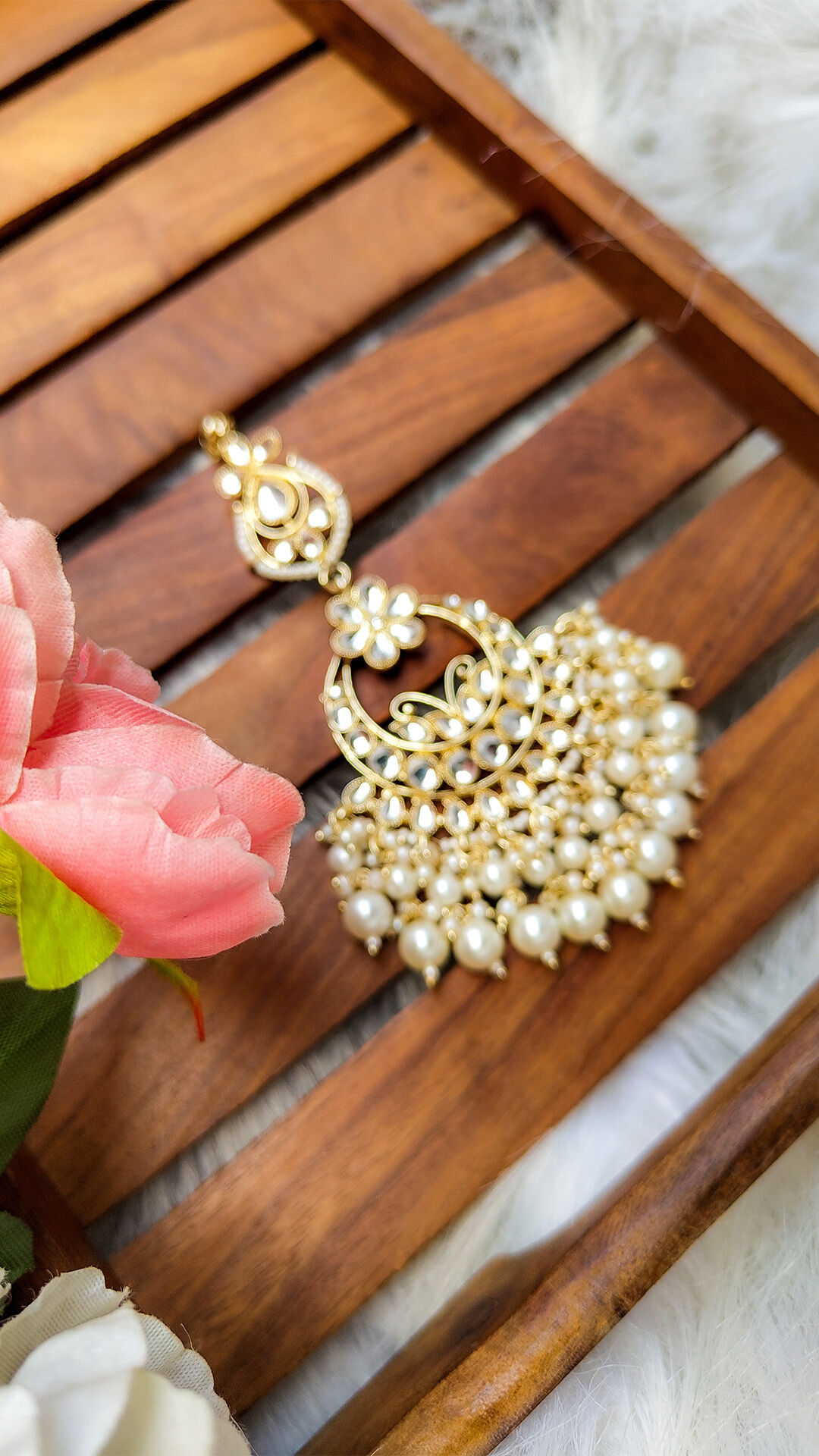STORIES BY MANYAVAR & MOHEY

Lifestyle
Symbolic Pieces of Indian Wedding Jewellery: A Meaningful Guide
Date 29 January 2025 Reading time: 7-10 mins
Indian weddings are known for their vibrant celebrations, heartfelt rituals, and of course – breathtaking traditional bridal jewellery. But these glittering pieces are more than just accessories. Each traditional ornament, from the shimmering maang tikka adorning the forehead to the sacred mangalsutra encircling the neck, carries a wealth of cultural meaning and auspicious symbolism.
In the grandeur of Indian weddings, jewellery plays a starring role. It's not just about accessorising the bridal ensemble – though a stunning wine-coloured floral saree with stone embellishments or a radiant red and mustard bridal lehenga certainly deserves some show-stopping jewels. More than mere adornment, traditional Indian bridal jewellery carries deep cultural roots and auspicious meanings.
From the regal necklaces to the delicate nose rings, each piece has a story to tell. These ornaments are crafted not just from precious metals and glittering gemstones, but from centuries of tradition, symbolism, and blessings. They are heirlooms passed down through generations, imbued with the love and well-wishes of family.
As you embark on an exciting journey to shop for jewellery pieces and wedding planning, let's take a moment to unveil the profound significance behind these iconic pieces of Indian wedding jewellery.
The Significance of Indian Wedding Jewellery
In Indian culture, ornaments worn by the bride are seen as more than just wedding accessories – they are a symbolic representation of the bride's marital status, her family's heritage, and the sacred celebration of the wedding itself. The designs and motifs often carry religious or spiritual meanings, invoking the blessings of deities for a joyous and prosperous married life.
For instance, many Indian communities believe that a bride's beauty should be hidden from evil eyes on her wedding day. The elaborate wedding jewellery, especially the headpieces and veils, serve as a protective shield, deflecting negativity and safeguarding the bride's radiant aura.
The tinkling sounds of the bangles and anklets are also said to ward off evil spirits, while the shimmering metals and stones are believed to absorb negative energies. In a sense, the bridal jewellery becomes a symbolic armour, enveloping the bride in an auspicious cocoon as she steps into her new life.
A Deep Dive into the Traditional Bridal Jewellery
Indian wedding jewellery is a reflection of the country’s rich cultural heritage, steeped in centuries-old customs. Many timeless pieces like maang tikka adorning the forehead have often passed down through generations, and are deeply intertwined with rituals, making them a cherished and integral part of every Indian wedding.
Now, let's take a closer look at some of the most iconic pieces of Indian bridal jewellery and unravel the meanings woven into their designs:
The Bridal Maang Tikka: Its Meaning and Importance
The maang tikka, a resplendent ornament worn on the forehead, holds a place of honour in traditional bridal jewellery. A bridal maang tikka design consists of a delicate chain with a pendant resting between the eyebrows, The maang tikka is believed to stimulate the third eye chakra, enhancing the bride's inner wisdom and intuition.
In some regions, the maang tikka design incorporates the image of a serpent, symbolising fertility, regenerative power, and the eternal cycle of life. Other popular motifs include the sun and moon, representing the balance of masculine and feminine energies in marriage.
The placement of the maang tikka is also significant – it adorns the forehead, which is considered a sacred spot in Indian culture. It's believed that the bride's beauty and aura radiate most strongly from this point, and the maang tikka serves to highlight and accentuate this natural radiance.
Other Essential Pieces of Indian Wedding Jewellery
Beyond the bridal maang tikka designs, there is a treasure trove of other beautiful patterns and layouts for jewellery pieces that complete the Indian bridal look.
Many brides love to adorn themselves with gorgeous ornaments. Here we are with a list of a few of them with their symbolic significance:
- Nath (nose ring): Symbolises the bride's surrender and devotion to her husband. The nath is also associated with the Goddess Parvati, the epitome of wifely virtues.
- Jhumkas (chandelier earrings): Represent femininity, grace, and the joyful chimes of marital bliss. The long, dangling design draws attention to the bride's elegant neckline.
- Rani Haar (Long Necklace): This statement necklace represents royalty, elegance, and the bride’s new status in her marital life.
- Haath phool (hand harness): Extends from the fingers to the forearm, symbolising the bride's delicate beauty. It's believed to bring good fortune and prosperity to the marital bond.
- Chooda (bangles): Worn as a sign of prosperity and good fortune, bangles are believed to bring happiness and ensure the well-being of the bride’s new family.
- Kangan (Bracelets): Represents good luck and prosperity. Kangans are integral to a married woman’s identity and are said to bring blessings to the household.
- Kamarbandh (Waist Belt): Symbolises feminine grace and beauty while offering protection. It is also considered to bring stability and balance in life.
- Bichiya (Toe Rings): Traditionally worn by married women, toe rings are a symbol of marital commitment and are believed to strengthen fertility.
- Payal (anklets): The gentle tinkling of the bride's anklets is said to echo her heartbeats, symbolising the rhythm of married life. It's also believed to attract positive energies.
Each of these ornaments adds a layer of meaning to the bridal ensemble, turning it into a wearable tapestry of blessings, well-wishes, and cultural symbolism. Together, they create an auspicious aura around the bride, empowering her as she takes her first steps into matrimony.
The Mangalsutra: Symbol of Marriage and Commitment
Perhaps the most significant piece of traditional bridal jewellery is the mangalsutra – a sacred necklace that the groom ties around the bride's neck during the wedding ceremony. Consisting of a gold chain with black beads, the mangalsutra symbolises the unbreakable bond of marriage.
The word 'mangalsutra' translates to 'sacred thread of auspiciousness.' It's believed to carry the blessings and protection of the gods, shielding the couple from negative influences. The black beads are said to absorb evil energies, while the gold represents purity and prosperity.
In many communities, the mangalsutra design incorporates the symbols of the Vati Savitri and Yali, powerful talismans of marital fidelity and longevity. Some modern designs even interweave the couple's initials, birthstones, or anniversary elements, adding a personalised touch to this timeless tradition.
More than just a necklace, the mangalsutra becomes a cherished emblem of the bride's new identity as a married woman. It's a constant reminder of the love, trust, and lifetime commitment she shares with her spouse. Many women continue to wear their mangalsutras long after the wedding day, as a treasured symbol of their marital bond.
The Last Sparkle
From the glittering maang tikka to the sacred mangalsutra, traditional bridal jewellery assembles a stunning panorama of cultural symbolism and auspicious meanings. Each ornament carries the blessings and well-wishes of generations, enveloping the bride in a protective aura as she embarks on her marital journey.
As you plan your own special day, remember to choose your bridal jewellery as per your bridal saree. At Mohey we offer a wide range of gorgeous fabrics right from chiffon, and net saree to Banarsi saree. And as you browse through the stunning collection just make sure to embrace the joy of this special journey, savouring every detail of your wedding preparations.
Mohey - Jab Aap Taiyaar Hum Taiyaar!







